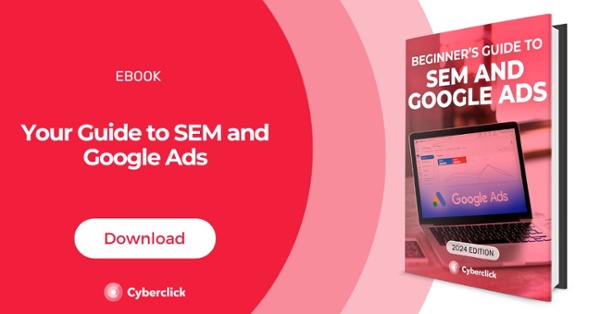- Home
- Cyberclick Academy
- SEM
- SEM on Google
How to Set Up and Optimize SEM Campaigns on Google Ads and Their Benefits
SEM Content
- What Is SEM? Definition, Advantages, Disadvantages, and Key Concepts
- SEO and SEM: Definition, Differences, and Combined Use
- SEM Positioning: Definition, Characteristics, and Advantages
- What Is a SEM Campaign? Definition, Advantages, and Examples
- What Is Search Engine Marketing? Definition and Basic Concepts
- How to Create a SEM Marketing Strategy for Your Company Step by Step
- How to Set Up and Optimize SEM Campaigns on Google Ads and Their Benefits
Index
SEM, or paid Search Engine Marketing, can be implemented through different platforms, but Google Ads is, by far, the most widely used platform by both consumers and advertisers. For brands, implementing SEM campaigns on Google is an excellent way to attract qualified traffic to their websites, increasing brand awareness as well as conversion results. Keep reading to discover how to set up a Google Ads campaign, along with our recommendations on how to optimize them to achieve the best possible results.
How to Create a SEM Campaign on Google Step by Step
1. Create a Campaign
To create your own SEM campaign on Google, the first thing you will need to do is register at https://ads.google.com (or log in if you already have an account). From there, you will be able to start creating your campaign.
The first step will be to define the objective of the campaign and then to choose a campaign type. There will be several options, so it is important to choose an objective that fits what you want to achieve. Selecting the appropriate campaign type based on your goals (e.g., traffic, sales, leads) is still essential.
At the campaign level, we will also make the following decisions:
- The Location: Where are the users you want to reach?
- Language: What language or languages do they speak?
- Bid Strategy: You can choose between automatic bidding and manual bidding.
- Campaign Daily Budget: Set a budget.
2. Create Ad Groups
Once the campaign is created, the next step will be to create ad groups, which serve to organize campaigns internally. Think of the ad groups as the different "topics" of the ads, that contain sets of ads and the keywords they are associated with.
This means that each campaign can have multiple ad groups, and within each of these ad groups, you'll find various ads tied to specific keywords. It's crucial that the content of the ads in each group closely aligns with the group's keywords to capture the user's attention and meet their search intent.
3. Select Keywords
A fundamental part of SEM is the understanding that search engine advertising is inherently tied to keywords. Users enter keywords into a search engine with the intention of retrieving pertinent information related to their query. This can range from a solitary word to a sequence of words, or even a comprehensive phrase.These same keywords will define when and which ads are displayed to users.
It's important to know and understand which words are most searched for by users, what they are expecting to find, and how you can place ads for these words. Moreover, as you're competing against other advertisers, it's essential to thoroughly research your market and understand your competitors' strategies.
Another aspect to take into account when choosing keywords for SEM in Google is the level of agreement. To what extent do you match the user's search with the exact terms of the keyword(s). You have the following options:
- Broad Match: Includes related words and synonyms.
- Phrase Match: Includes more precise meanings of keywords, even if additional words are included before or after, and includes slight variations
- Exact Match: As the name implies, the keyword must exactly match the term that the user enters in the search engine.
4. Create the Text for the Ads
Finally, you will need to introduce the different variations of ads that will be shown in the search engine when users search for the keywords in your list. Two or three ads for each group should be enough.
In addition to the description and the title of the ads, you can also configure some ad extensions so that the user has more information. There are many different types, which can be adapted to multiple objectives and needs, but these four are usually most useful for companies.
- Link Extensions: These link to other pages of your website (in addition to the one that has been included as an ad landing page).
- Text Extensions: Additional texts to explain the offer in greater depth.
- Call Extensions: For potential customers to contact the company directly.
- Location Extensions: Ideal if you want to generate more traffic in a physical store.
Tips to Optimize Your SEM Campaign on Google
1. Investigate Your Keywords Thoroughly
Keywords are like the "bricks" of your SEM campaign on Google. If you appear by the appropriate terms, the chances of success multiply, but if you choose too competitive or generic terms, it will be much more difficult to generate conversions. The key to getting it right is to spend as much time as you need to research keywords before launching the first campaign. In addition, the information you generate will also be very valuable when it comes to better guiding your SEO.
2. Run A/B Tests
Google Ads offers multiple elements that lend themselves to optimizing, such as the title or the visible URL of the ads. The only way to know which variant will give the best results is by testing it in a controlled manner, by experiments such as the A/B tests. Ideally, this type of testing is always taking place within the account to publish increasingly better ads.
3. Evaluate the Results
Periodic checks are the only possible way to see what is working and what is not within an account to continue optimizing the results. Therefore, we should never fall into the error of thinking that "your work is done" after launching a campaign.
4. Bet on Simplicity
Starting with a focused campaign structure is advisable (fewer campaigns, groups, keywords), especially for small and medium businesses. There is always time to grow later as the budget and expectations increase.
5. Strategically Manage Your Budget
SEM in Google calculates many factors automatically to offer the best possible results within the budget set by the advertiser. Therefore, if we are changing it continuously, the system will never fully optimize, and we will obtain worse results in the long run. The smartest option is to divide the monthly budget by 30.4 and allocate that budget to each day invariably.
6. Pay Attention to Quality
Within the multitude of metrics offered by SEM in Google, it is necessary to distinguish between those that can truly make a difference in the performance of the account. And without a doubt, the most important of all is the level of quality. The quality level is a score awarded by Google Ads based on the perceived quality of the ads. In turn, it is calculated using parameters such as the expected click rate, relevance, and experience of the landing page. The higher the level of quality, the better the ads will rank and the lower the cost per click.
7. Keep an Eye on Profitability
In the end, the most important metric is always the same: the ROI. What we are looking for with Google Ads is to generate conversions profitably, so we always have to control how much we are spending on campaigns and what is the value generated in the form of conversions.
Benefits of SEM
You might be wondering whether SEM should be an addition to your digital marketing strategy. Undoubtedly, search engine marketing is a potent tool suitable for nearly all types of brands. To better assess when and how to integrate it, it's crucial to understand its key advantages.
Highly Measurable
Tools like Google Ads offer detailed reports on your campaign's progress, allowing you to know exactly what's happening with your ads at all times. Additionally, integration with Analytics ensures everything is perfectly monitored.
Real-Time Tracking and Editing
Analytical interfaces let you see live updates, enabling immediate course corrections if you're not seeing the desired results.
Pay-Per-Click
You only pay for the clicks you actually get. You can always control your maximum daily and total budget, and the maximum cost per click you're willing to pay. This ensures that the campaign remains profitable and within your means.
Speed
Compared to other techniques like SEO or content marketing, search engine marketing can yield relatively quick and large-scale results, depending on how much you are willing to invest.
Accessibility
With scalable investments, this solution suits large corporations and small businesses alike. They compete in the quest to secure top positions for as many or as few keywords as they deem appropriate.
Segmentation
Another strong point is the way this platform segments. Because it’s keyword-oriented, it targets an audience actively interested in your brand or the solutions you offer. Plus, it allows filtering by other factors like location, language, or behavior.
SEM in Google has great potential to help companies achieve their goals quickly and in a scalable way. However, while launching a basic SEM campaign might be straightforward, ad platforms offer numerous options and tools that can be overwhelming, especially for beginners. Developing an advanced and comprehensive strategy might benefit from expert guidance, and to get the most out of SEM, it's ideal to have experts who have extensive experience positioning brands with Google Ads.
Recent Updates and Trends
- Campaign Types: Starting in March 2025, Google Ads will transition video action campaigns into Demand Gen campaigns. Advertisers will no longer have the option to create new video action campaigns, and existing ones will be automatically converted.
- AI Integration: The use of artificial intelligence in SEM is increasing, with AI assisting in automated bidding, keyword optimization, and campaign personalization.
- Voice Search Optimization: With the rise of voice assistants, optimizing for voice search keywords is becoming more important.
- Mobile Optimization: Ensuring that ads and landing pages are optimized for mobile devices is crucial, given the increasing use of mobile search.
- Advanced Targeting: Utilizing advanced targeting options, such as audience targeting and remarketing strategies, can boost campaign effectiveness.
If you want to take advantage of all the benefits of SEM in Google for your brand, get in touch with us!
Key Account Manager Engineer at Cyberclick. Expert in web application development and system integrations with over 10 years of experience. He holds a degree in Mathematics, a Higher Degree in Computer Application Development, and a Higher Degree in Multiplatform Application Development.
Recursos para seguir aprendiendo: ebooks, vídeos y cursos

Cyberclick

Cyberclick

Cyberclick

Cyberclick

Cyberclick



